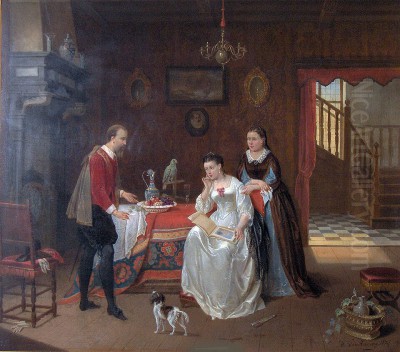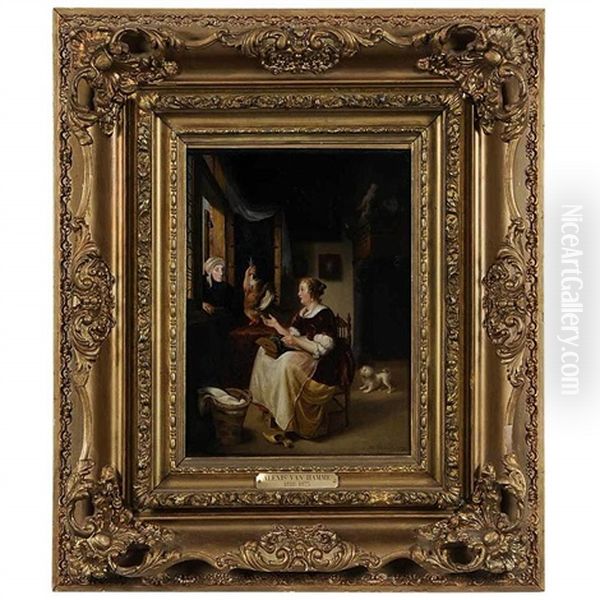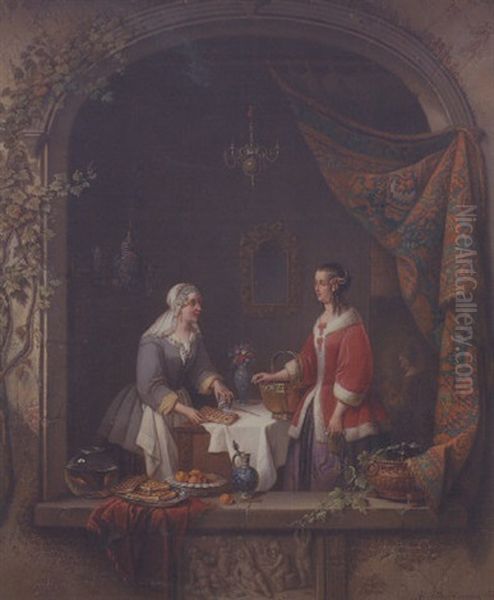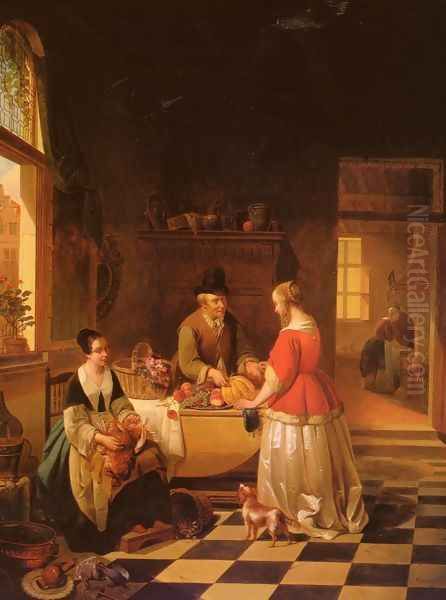
Alexis van Hamme (1818-1875) stands as a notable figure within the rich tapestry of 19th-century Belgian art. Active during a period of significant national and artistic development, Van Hamme dedicated his talents to capturing the nuances of everyday life and the quiet dignity of ordinary people. Working primarily in oils and occasionally watercolors, his oeuvre consists largely of genre scenes, portraits, and still lifes, all rendered with a characteristic attention to detail and a subtle understanding of human character. Though perhaps not as widely known today as some of his more bombastic contemporaries, Van Hamme's work offers a valuable window into the social fabric and artistic sensibilities of his time, particularly within the context of Belgian Romanticism and the enduring tradition of Netherlandish genre painting.
Birth, Artistic Milieu, and Formative Influences
Born in Belgium in 1818, Alexis van Hamme emerged as an artist during a vibrant period for the newly independent nation. The 19th century in Belgium was marked by a burgeoning sense of national identity, which found fervent expression in the arts. Historical painting, often on a grand scale, was particularly favored as it allowed artists to celebrate the nation's past glories and heroic figures. Within this environment, the Royal Academy of Fine Arts in Antwerp and its counterpart in Brussels were central institutions, shaping generations of artists.
While specific details of Van Hamme's earliest training are not extensively documented, it is known that he was part of the artistic currents that defined Belgian Romanticism. He is considered an important figure in the realm of Belgian Romantic historical painting, sharing this distinction with prominent artists such as Nicaise De Keyser (1813-1887). Indeed, some sources suggest that Van Hamme may have been a student of De Keyser, a leading painter, director of the Antwerp Academy, and a pivotal figure in the Belgian Romantic school. De Keyser himself was a pupil of Joseph Jacops and was influenced by the historical painter Gustaf Wappers (1803-1874). If Van Hamme did study under De Keyser, he would have been immersed in an environment that valued technical skill, historical accuracy (albeit often romanticized), and emotionally resonant subject matter.

The artistic landscape of Belgium at this time was rich and varied. Besides De Keyser and Wappers, other significant figures included Hendrik Leys (1815-1869), known for his meticulously researched historical scenes that often evoked the spirit of earlier Flemish masters, and Louis Gallait (1810-1887), whose historical paintings were celebrated for their dramatic intensity. Antoine Wiertz (1806-1865) was another contemporary, known for his often colossal and sometimes eccentric philosophical and historical works. This was the world that shaped Van Hamme, a world where technical proficiency was paramount and art played a significant role in cultural and national discourse.
The Artistic Style and Thematic Concerns of Alexis van Hamme
Alexis van Hamme's artistic style is characterized by a meticulous realism, a keen eye for detail, and a sensitive handling of light and shadow. While he operated within the broader sphere of Romanticism, his work often leans towards the more intimate and less grandiose aspects of the movement, particularly in his genre scenes. These depictions of everyday life, often set in domestic interiors, showcase his ability to create convincing portrayals of textures, fabrics, and the subtle interplay of light on surfaces.
His primary focus was on genre painting – scenes of ordinary people engaged in daily activities. This tradition had deep roots in Netherlandish art, harking back to the Golden Age masters of the 17th century such as Johannes Vermeer (1632-1675), Pieter de Hooch (1629-1684), Gabriel Metsu (1629-1667), and Gerard ter Borch (1617-1681), whose intimate portrayals of domestic life were celebrated for their realism and psychological insight. Van Hamme, like many 19th-century artists, drew upon this rich heritage, adapting it to contemporary sensibilities. His figures are often imbued with a quiet dignity, and his compositions are carefully constructed to draw the viewer into the depicted scene.
Van Hamme's paintings often feature solitary figures or small groups within well-defined interior spaces. The settings are typically rendered with great care, with attention paid to furniture, household objects, and costumes, all of which contribute to the narrative and social context of the scene. His palette tends to be rich but controlled, and his brushwork is generally smooth and polished, allowing for a high degree of finish. This emphasis on verisimilitude and detailed rendering aligns with the academic training prevalent in the 19th century.

Beyond genre scenes, Van Hamme also produced still lifes and portraits. His still life paintings would have allowed him to showcase his technical skill in rendering different textures and surfaces, a hallmark of the Netherlandish tradition. In portraiture, his attention to detail would have served him well in capturing a sitter's likeness and character. The influence of Southern Netherlandish art, with its traditions of naturalism, can be discerned in his approach. Some art historical commentary also notes a potential influence from artistic trends in Rome and Naples, particularly concerning naturalism, though this is less explicitly detailed in readily available sources for Van Hamme specifically.
Masterpieces and Representative Works
Several works by Alexis van Hamme are frequently cited and help to illustrate his artistic preoccupations and stylistic characteristics. Among his most well-known genre scenes are The Lace Maker and The Waffle Seller.
The Lace Maker, painted in 1848, is a quintessential example of Van Hamme's intimate genre scenes. The painting, measuring 53cm x 44cm, depicts a woman seated, engrossed in the delicate task of lace making. She is situated within a domestic interior, likely her workspace, surrounded by the tools of her trade. Van Hamme's skill is evident in the rendering of the textures – the fabric of the woman's dress, the threads of the lace, the wood of the furniture. The lighting is carefully managed to highlight the figure and her activity, creating a sense of quiet concentration. The work is noted as having been in the inventory of Heathfield Park, Sussex, in 1937, and was presented in a gilded frame, typical for paintings of this period. The subject of a woman engaged in a skilled craft was a popular one in 19th-century art, often romanticizing domestic labor and traditional skills. This painting can be seen in the lineage of works by artists like Vermeer, who also depicted women engaged in quiet, focused activities within domestic settings.

The Waffle Seller, completed in 1858, is another significant work. This painting, measuring 36 inches by 32 inches (approximately 91.4cm x 81.3cm), presents a female figure, the waffle seller, likely in an interior setting related to her work. The source material indicates that this painting, like many genre scenes of the period, subtly conveys information about social class through details of costume and accessories. For instance, the richness of fabrics, the presence of fur trim, or items like a purse and keys could signify the subject's economic standing or role within a household. In this case, the description suggests that the attire of the figure – perhaps the quality of her robe, any silk or satin elements – would indicate a certain level of affluence or status, distinguishing her from a mere street vendor and perhaps placing her as a prosperous artisan or a member of a comfortable household. The keys, often symbolic of domestic authority and responsibility for valuable goods like spices or linens, further enrich this interpretation. Van Hamme's meticulous rendering of these details would have been crucial to conveying these social nuances to his contemporary audience.
Other works attributed to Van Hamme include The Fruit Seller, which would align with his interest in genre subjects and potentially allow for a display of skill in still life elements within a figurative composition. More intriguingly, he is also credited with allegorical paintings such as The Allegory of Air and The Allegory of Water. The Allegory of Air is even cited as possibly his most famous work. Allegorical subjects were common in academic art, often personifying abstract concepts through classical or symbolic figures. It would be interesting to see how Van Hamme, primarily known for his realistic genre scenes, approached such themes. He might have integrated allegorical elements into realistic settings or adopted a more traditionally classical mode for these compositions. These works suggest a broader thematic range than his more frequently discussed genre paintings.
The precision and careful execution in these works demonstrate Van Hamme's academic training and his affinity for the detailed realism that characterized much of 19th-century Belgian painting. His choice of subjects, focusing on the everyday, also reflects a broader European trend in the 19th century, where artists increasingly turned away from purely historical or mythological themes to explore the lives and experiences of ordinary people. This was a domain also explored by French artists like Jean-François Millet (1814-1875) with his peasant scenes, or Gustave Courbet (1819-1877) with his powerful Realist depictions, though Van Hamme's style is generally more polished and less overtly political than Courbet's.
Contemporaries and Artistic Connections
Alexis van Hamme was active during a period of intense artistic activity in Belgium and across Europe. His connection to Nicaise De Keyser, as a potential student, places him firmly within the orbit of the Belgian Romantic school. This school, as mentioned, included figures like Gustaf Wappers, Hendrik Leys, and Louis Gallait, all of whom contributed to a national style that blended Romantic fervor with academic precision. Another Belgian artist whose work in genre painting gained international recognition, though slightly later and with a more modern sensibility, was Alfred Stevens (1823-1906), known for his elegant portrayals of fashionable women in Parisian society.
Beyond Belgium, the tradition of genre painting was alive and well. In France, artists like Jean-Louis-Ernest Meissonier (1815-1891) achieved enormous success with their meticulously detailed historical genre scenes, often on a small scale. In Germany, the Biedermeier period saw a flourishing of intimate genre scenes, with artists like Carl Spitzweg (1808-1885) capturing the charming and sometimes humorous aspects of everyday middle-class life. In the Netherlands, artists like Jozef Israëls (1824-1911) and the Maris brothers (Jacob, Matthijs, and Willem) continued the Dutch tradition of realism, often depicting scenes of rural life and seascapes.
The influence of earlier masters, particularly the Dutch Golden Age painters, remained profound for 19th-century genre artists like Van Hamme. The legacy of Vermeer, Metsu, Ter Borch, and Gerrit Dou (1613-1675) provided a benchmark for technical skill, compositional harmony, and the sympathetic portrayal of domestic life. Van Hamme's work, with its emphasis on detail, texture, and interior light, clearly participates in this long and distinguished tradition.
While Van Hamme's fame may have been primarily within Belgium during his lifetime, the themes and style he embraced were part of a broader European artistic conversation. The interest in everyday life, the meticulous rendering of detail, and the creation of narrative through subtle cues were all characteristics valued by a significant segment of the 19th-century art public and practiced by numerous artists across the continent.
Exhibitions, Collections, and Legacy
During his lifetime, Alexis van Hamme's works were likely exhibited at the various Salons and art exhibitions held in Belgium, which were crucial venues for artists to gain recognition and patronage. His paintings, with their accessible subject matter and evident skill, would have appealed to the tastes of the burgeoning middle-class art market as well as more established collectors.
Information provided suggests that works by Alexis van Hamme have been associated with or exhibited at several notable institutions. These include the Kunsthalle São Paulo in Brazil, the Kunstmuseum Den Haag (formerly Gemeentemuseum) in The Hague, Netherlands, the Kunstmuseum Luzern in Switzerland, and the Museum Voorlinden in Wassenaar, Netherlands. The presence of his work, or works of his school, in such diverse collections speaks to the appreciation for 19th-century European genre painting. Furthermore, it is mentioned that his works, or those by artists of his kind, might be found in major international museums such as Tate Modern in London, the Museum of Modern Art (MoMA) in New York, various Kunsthäusern (art museums) in German-speaking countries, and the Städel Museum in Frankfurt. While MoMA and Tate Modern primarily focus on modern and contemporary art, many older, comprehensive museums do hold 19th-century academic and genre paintings. It's plausible that his works are held in the 19th-century collections of large encyclopedic museums or specialized institutions focusing on this period.
Like many artists of the Romantic and Academic traditions, Van Hamme's reputation experienced a period of decline with the rise of Impressionism and subsequent modernist movements in the late 19th and early 20th centuries. Tastes shifted, and the detailed realism and narrative content of painters like Van Hamme were often overshadowed by newer, more avant-garde approaches to art. The source material notes that his fame, while present in his time, gradually faded, a fate shared by many Belgian Romantic painters whose influence waned in the 20th century.
However, in more recent decades, there has been a scholarly and public reassessment of 19th-century academic and genre art. Art historians and curators have increasingly recognized the technical skill, cultural significance, and aesthetic appeal of these works. Artists like Van Hamme are now seen as important contributors to their national artistic heritage and as skilled practitioners within established European traditions. His paintings offer valuable insights into the social customs, domestic life, and artistic values of 19th-century Belgium. They are a testament to a painter who, with diligence and sensitivity, chronicled the world around him, leaving behind a legacy of carefully observed and beautifully rendered scenes.
It is important to distinguish Alexis van Hamme the painter from other individuals with similar names who have gained prominence in different fields. For instance, a Canadian writer named Alex Van Hamme and the renowned Belgian writer Jean Van Hamme, famous for comic book series like "XIII" and "Largo Winch," are entirely separate individuals with no direct connection to the 19th-century painter's artistic career. Similarly, an anecdote involving an encounter with astronaut Chris Hadfield pertains to the Canadian writer Alex Van Hamme, not the painter. These distinctions are crucial for an accurate understanding of Alexis van Hamme's life and work.
Conclusion: The Enduring Appeal of Alexis van Hamme's Art
Alexis van Hamme was a skilled and dedicated Belgian painter who made a significant contribution to the genre painting tradition in the 19th century. His works, characterized by their meticulous detail, sensitive portrayal of figures, and evocative depiction of everyday life, reflect both the broader currents of European Romanticism and the specific artistic concerns of his Belgian context. Through paintings like The Lace Maker and The Waffle Seller, he captured moments of quiet industry and domesticity, imbuing them with a sense of dignity and timeless appeal.
While his name may not resonate as loudly today as some of the revolutionary figures who followed him, Van Hamme's art retains its power to charm and inform. His paintings serve as valuable historical documents, offering glimpses into the material culture and social nuances of his era. Moreover, they stand as testaments to a high level of artistic craftsmanship and a genuine engagement with the human condition as observed in the ordinary moments of life. As art history continues to broaden its scope and re-evaluate figures from the past, artists like Alexis van Hamme are increasingly appreciated for their unique contributions and their role in the rich and diverse story of 19th-century European art. His legacy is that of a careful observer and a skilled narrator in paint, a chronicler of his time whose works continue to engage viewers with their quiet beauty and understated realism.